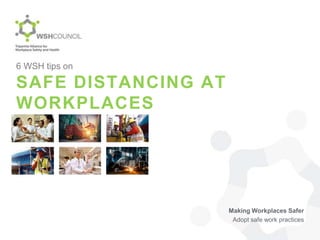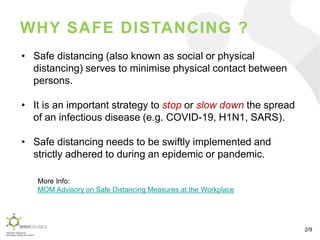Safe_Distancing_at_Workplaces.pptx
- 1. 6 WSH tips on SAFE DISTANCING AT WORKPLACES Making Workplaces Safer Adopt safe work practices
- 2. ŌĆó Safe distancing (also known as social or physical distancing) serves to minimise physical contact between persons. ŌĆó It is an important strategy to stop or slow down the spread of an infectious disease (e.g. COVID-19, H1N1, SARS). ŌĆó Safe distancing needs to be swiftly implemented and strictly adhered to during an epidemic or pandemic. WHY SAFE DISTANCING ? 2/9 More Info: MOM Advisory on Safe Distancing Measures at the Workplace
- 3. WSH Tip 1 Work from home (WFH) whenever possible 3/9
- 4. WSH Tip 2 Use the phone, or explore teleconferencing to communicate 4/9
- 5. WSH Tip 3 If WFH is not possible, avoid crowds by adopting staggered working hours and meal times 5/9
- 6. WSH Tip 4 Defer or cancel all non-essential events 6/9
- 7. WSH Tip 5 Ensure workstations are at least one (1) metre apart 7/9
- 8. WSH Tip 6 Maintain at least one (1) metre physical spacing during briefings, meetings, and meals 8/9
- 9. PRACTISE SAFE DISTANCING TO REDUCE RISK OF DISEASE TRANSMISSION Read more at: www.mom.gov.sg/covid- 19/advisory-on-safe-distancing-measures
Editor's Notes
- #3: There are various safe distancing measures that can be implemented at workplaces ŌĆō 6 of which will be covered in this set of slides. Such measures are to limit close contact between persons and prevent large gatherings of people in close proximity over a prolonged duration. When combined with good personal hygiene and social responsibility, these measures can help to suppress the spread of an infectious disease. Severe respiratory diseases such as COVID-19 and SARS can be detrimental to our everyday lives, and have resulted in thousands of deaths globally. Do your part at the workplace by practising safe distancing to minimise the risk of disease transmission during a virus outbreak. Note: An epidemic occurs when an infectious disease spreads across one city, region, or country. A pandemic occurs when an infectious disease spreads across a wide geographical area beyond national borders, possibly worldwide.
- #4: Employers and principals must provide the necessary IT equipment and direct their workers to work from home whenever possible depending on the nature of the job. Working from home helps to significantly reduce the density of persons at the workplace. It also helps to reduce the density of persons on public transport (especially trains and buses). Employees are to strictly adhere to the work from home arrangement during an epidemic/pandemic.
- #5: Avoid physical meetings as much as possible and make use of technological options for tele- or video- conferencing. This helps to reduce contact between persons at the office, thereby lowering the risk of disease transmission. If there is a critical need for a physical meeting to proceed, limit the number of attendees and keep the meeting as short as possible.
- #6: For workers unable to work from home due to the nature of their work (such as frontline operations and fieldwork at construction sites, shipyards or plants), employers and principals can implement staggered working hours so that workers can avoid crowds during peak hours. The staggered hours should apply to : Reporting time for work and dismissal time from work (to avoid crowds during the commute to-and-from work) Start and end time for meals (to avoid crowds at public eating places and/or the office canteen) Start and end time for breaks (to avoid crowding in the office pantry or rest areas) Suggestion is to implement staggered working hours over at least three 1-hourly blocks, with not more than 50% of the employees reporting to work or having their meals within each 1-hour block. For example, if the normal working hours are from 9am to 6pm, employers could stagger employeesŌĆÖ reporting times at one-hour intervals between 7.30 am and 10.30 am (e.g. 7.30 am to 8.30 am, 8.30 am to 9.30 am and 9.30 am to 10.30am), with corresponding staggered timings for end of work.
- #7: There may be workplace activities which involve close and/or prolonged contact amongst participants. Employers should defer (postpone) or cancel all such events or activities. These could include employee briefings, dialogues, training sessions as well as employee participation in conferences, seminars, forums and exhibitions. Advise employees to adhere to the designated work arrangement (e.g. working from home) during working hours.
- #8: Employers must provide for wider physical spacing (at least 1m apart) for workstations (e.g. by manually separating or by clearly marking out the workstations that can be used to achieve the 1m spacing). Seating in boardrooms and meeting rooms should also be spaced at least 1m apart and clearly marked. This will help to significantly reduce the density of persons at the office and meeting rooms, thereby lowering the risk of disease transmission. The same safe distancing measures should also apply to common spaces such as office entrances/exits, lifts, pantries/canteens, where congregation or queuing of employees or visitors/clients might occur. Employees are to strictly adhere to these safe distancing measures.
- #9: Adopt measures to ensure safe distancing of at least one metre between individuals during the following (non-exhaustive) scenarios: Briefings Meetings Meal times Any other work situations involving 2 or more persons Ensure employees adhere strictly to these physical spacing measures. This will help to significantly reduce the risk of disease transmission at the workplace.








